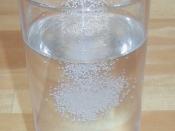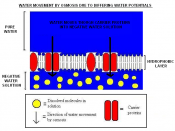ANALYSIS
There are four basic ways in which molecules can move from one area to another. They are:
÷Diffusion
÷Osmosis
÷Active Transport
÷Bulk Transport
In this experiment we are looking at osmosis. To be able to analyse and explain this experiment, we have to know what osmosis is. Osmosis is the movement of molecules from an area of higher water potential, to an area of lower water potential through a partially permeable membrane. At some point, the molecules will be equal on either side of the membrane. This is known as the molecules being in equilibrium. A definition of equilibrium is the stage where a tissue neither gains, or losses their mass. So, the water potential of the tissue, is the same as the water potential of the solution. How concentrated a solution is will effect the mass of the tissue. For this experiment, I found that the general rule was the more concentrated the solution, the mass of the tissue started to decrease.
In this experiment we can work out when the tissues, potato and swede are in equilibrium by plotting our results on a graph. Then by using a line of best fit, we can estimate when the line crosses the x-axis. From my results, I know that at some point between 0.2 moles and 0.4 moles, the potato was in equilibrium. Using a line of best fit, I can estimate when the potato was in equilibrium. It was estimated that this was reached at 0.22 moles. At some point between 0.6 and 0.8, the swede was in equilibrium. Again, by using a line of best fit, it was estimated that equilibrium was reached at 0.64 moles.
Below is a table of what the concentration of solution (moles) has been transferred into water potential (Kpa). This was...


